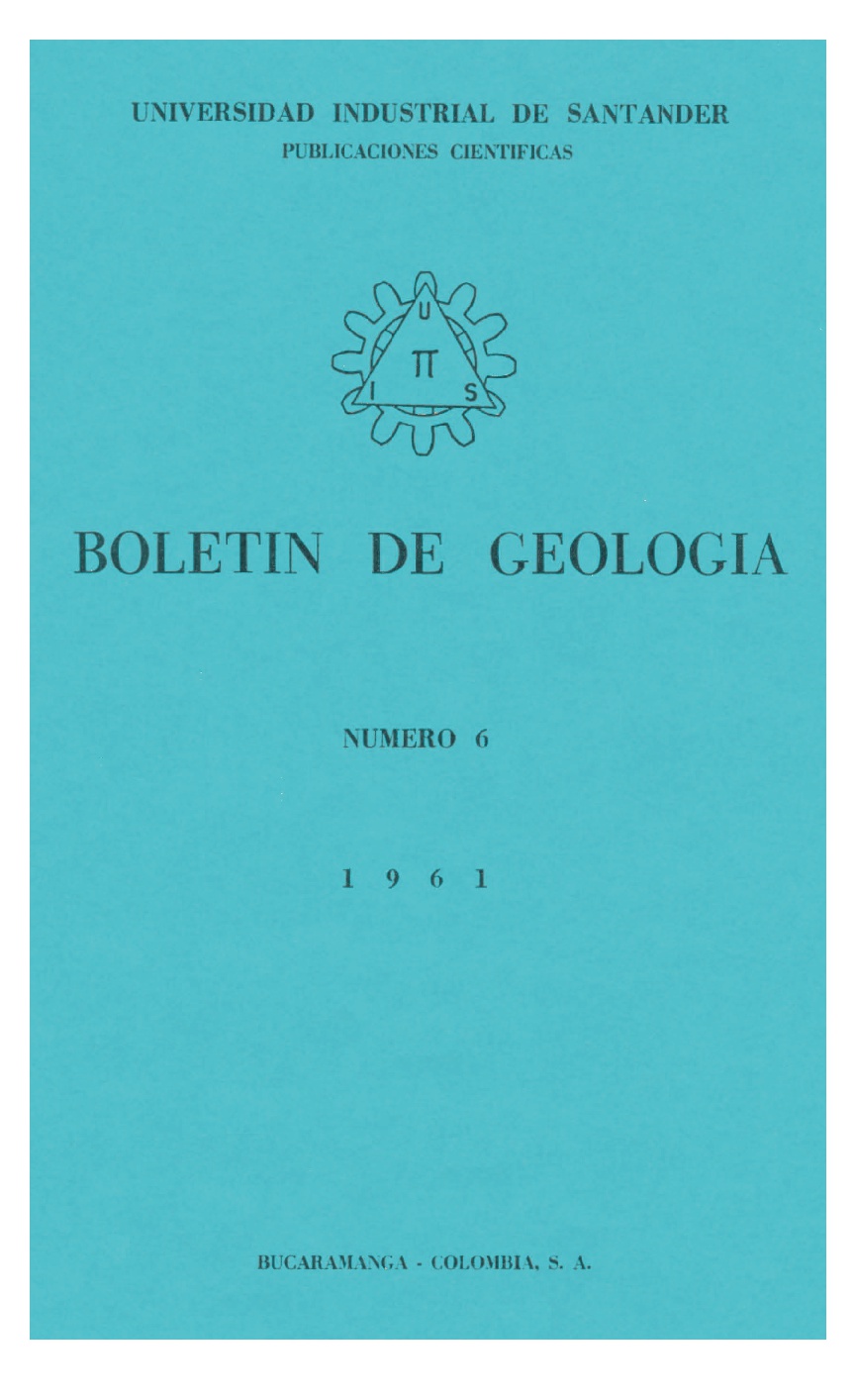Publicado 1961-04-06
Cómo citar
Resumen
RESUMEN.—El Valle Medio del Magdalena es una semifosa, hundida hacia el E donde limita con una importante falla: la falla de La Salina. Las estructuras internas de este bloque son en general suaves, su característica principal es la asociación de un anticlinal, una falla inversa, paralela al mismo y próxima a la cresta y una red de fallas directas en la cresta anticlinal. Los pliegues y fallas inversas asociadas, llevan dirección NNE — SSW. En la formación de estas estructuras ha influido grandemente el zócalo. Analizando la evolución de estas estructuras en el tiempo se llega a la conclusión de que la orogénesis iniciada con el terciario (aunque tal vez existan algunos indicios ya a finar les del cretácico) se desarrolla de un modo prácticamente continuo a lo largo de todo el terciario. La semi-fosa del Valle Medio del Magdalena constituye un lugar apropiado para el análisis del desarrollo de la orogénesis en el tiempo, por cuanto la sedimentación se prosigue en ella a lo largo de todo el terciario, al mismo tiempo que se van originando las estructuras. Durante el terciario en el bloque del Medio Magdalena ha habido superposición de dos fenómenos: a) subsidencia general, más acentuada hacia el E; b) creación de estructuras anticlinales que con su tendencia a la elevación con respecto a la subsidencia general, tendían a atenuarla o incluso se imponían a ella. La subsidencia general del bloque fue suficiente para asegurar una continuidad en la sedimentación en las áreas sinclinales, las áreas anticlinales fueron sometidas a erosión o sedimentación alternativamente según predominara la subsidencia general o la elevación de los anden. nales. Como consecuencia, en las zonas anticlinales se observan frecuentes discordancias angulares aunque muy débiles, si se exceptúa la discordancia cretácicoterciaria; esto va asociado al hecho de que la serie terciaria no es completa. En las áreas sinclinales la serie es completa y hay prácticamente concordancia. En los flancos de los pliegues hay discordancias progresivas y acuñamientos de capas. Se hacen algunas consideraciones sobre las condiciones de acumulación del petróleo.
ABSTRACT.— The Middle Magdalena Valley is a semi-graben, sunk towards the east, where it is delimited by an important fault: the Salinas Fault. The internal structures of ibis block are, in general, gentle, their principal characteristics being the association oi an anticline, a thrust fault parallel to it, and also close to its crest, a network of normal faults on Use anticlinal crest. The folds and associated thrust faults have a strike of NNE — SSW. The basament has liad a considerable influence in the formation of these structures. Analizing the evolution of these structures throughout time, one arrives at the conclusion that Use orogenisis initiated in the Tertiary (although perhaps at the close of the Cretaceous diere were already indications of it) is developed in a practically continous manner throughout Use whole of Use Tertiary. The semi-graben of the Middle Magdalena Valley is an appropiate region in which to analize the development oi orogenisis throughout time, since sedimentation there is practically continous throughout the whole of the Tertiary while the structures are simultaneously being, formed. The superposition of two phenomena bas occurred in the Middle Magdalena block during the Tertiary: a) general subsidence, more accentuated towards the east, and b) the creation of anticlinal structures which, with a tendency to uplift in comparison with the general sinking, tended to attenuate the latter or even took precedence over it. The general subsidence of the block was enough to assure continous sedimentation in the synclinal areas; on the otherhand, the anticlinal areas were alternately subjeted to erosion and sedimentation, depending on whether uplift of the anticlines or general subsidence predominated. In consequence, in the anticlinal zones, frequent angular unconformities can be observed. These are weak, if one excepts the one between the Cretaceous and Tertiary. At the same time, the Tertiary series in these zones is complete. In the synclinal zones, the tertiary series is complete and practically conformable. On the Hanks of the folds, there are pro. gressive unconformities and pinching out of beds. A few considerations are drawn regarding the conditions governing the accumulation of petroleum.
RESUME.— La vallée moyenne du Magdalena constitue un bloc affaissé vers l'Est où il limite avec une faille importante: la faille de La Salina, La tectonique du bloc du Magdalena est dominée par l'association d'une structure anticlinale, d'une faille inverse parallèle et d'un réseau de 'Iailles directes. Plis et failles inverses ont une orientation NNE — SSW. Le socle joue un rôle très important sur la formation de ces structures. L'étude de l'évolution de toutes ces structures dans le temps permet d'arriver à la conclusion. que l'orogène commencée au débout du tertiaire (on peut être à la fin du crétacée), se développe d'une façon continue tout le long du tertiaire. Pendant le tertiaire le bloc du Magdalena vient caractérisé par une subsidence générale; ainsi deux phénomènes se sont superposés: a) subsidence générale, plus accentuée vers l'Est, b) formation des structures anticlinales tendant au soulèvement. Dans les aires synclinales la sédimentation pendant le tertiaire demeure sans interruption, par contre les aires anticlinales étaient soumises à érosion ou sédimentation d'après la predominance de la subsidence 'générale du bloc ou l'élévation des anticlinaux. Sur les anticlinaux on apperçoit souvent des discordances et la serie tertiaire n'est pas complète, néanmoins tous les périodes du tertiaire y sont répresentés à exception du paleocène. Dans les zones synclinales la série apparaît complète et concordante et sur les flancs il y a amincissement et disparution des couches. On fait quelques remarques sur les conditions d'accumulation du pétrole.
